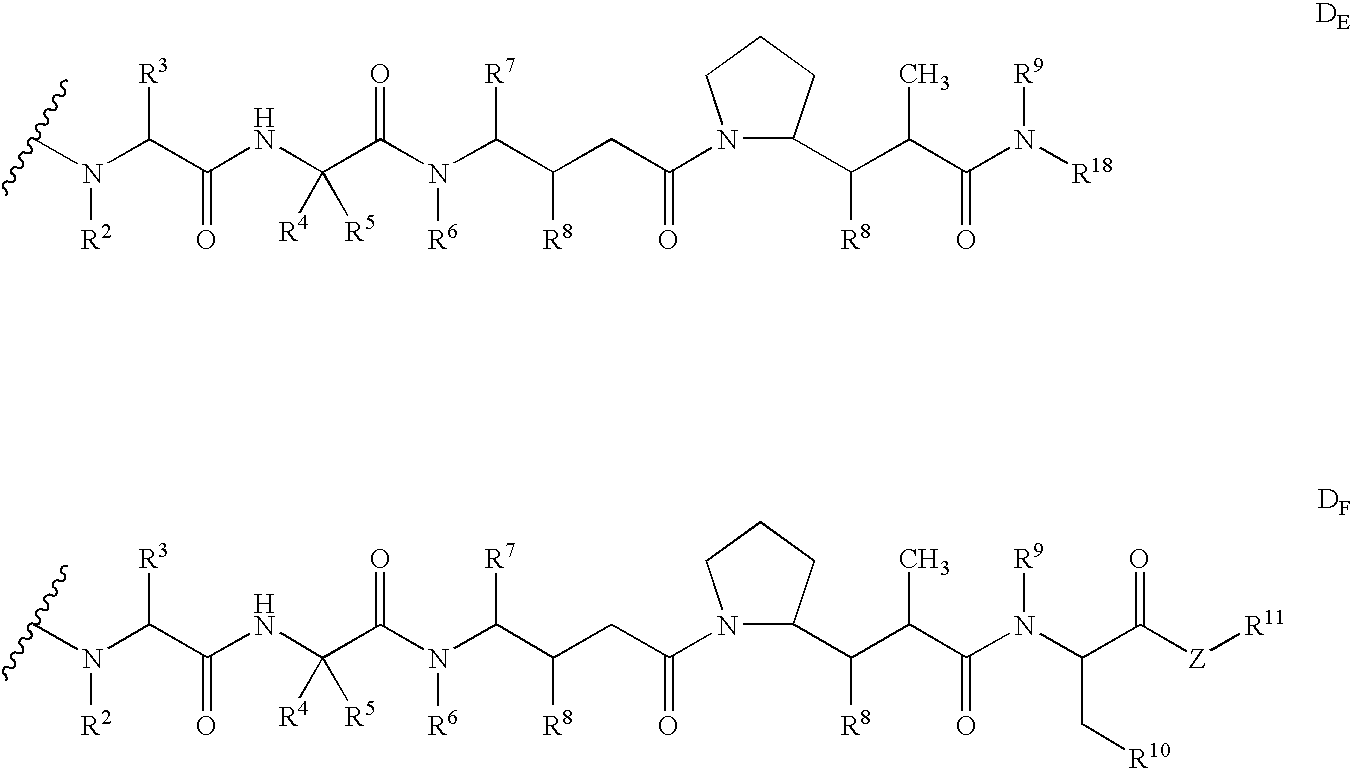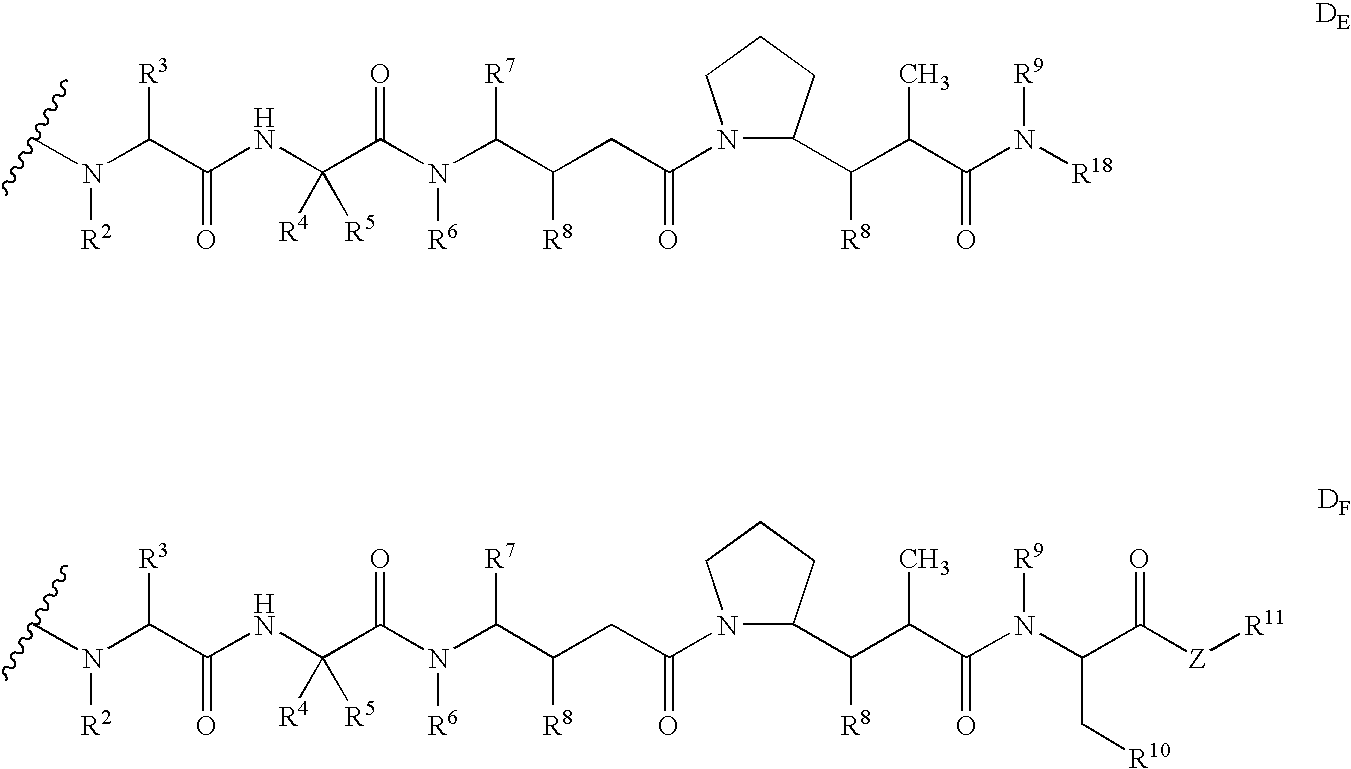Monomethylvaline compounds capable of conjugation to ligands
a monomethylvaline and compound technology, applied in the field of drug compounds, can solve the problems of difficult or inefficient intracellular targeting, difficult or inconvenient development of effective methods, and inability to minimize the redistribution of drugs, e.g., to neighboring cells, and achieve the effect of improving the bioavailability of antibody-drug conjugate compound or intracellular metabolite of compound in mammalian cells
- Summary
- Abstract
- Description
- Claims
- Application Information
AI Technical Summary
Benefits of technology
Problems solved by technology
Method used
Image
Examples
example 1
Preparation of Compound AB
[1055]
[1056] Fmoc-val-cit-PAB-OH (14.61 g, 24.3 mmol, 1.0 eq., U.S. Pat. No. 6,214,345 to Firestone et al.) was diluted with DMF (120 mL, 0.2 M) and to this solution was added a diethylamine (60 mL). The reaction was monitored by HPLC and found to be complete in 2 h. The reaction mixture was concentrated and the resulting residue was precipitated using ethyl acetate (ca. 100 mL) under sonication over for 10 min. Ether (200 mL) was added and the precipitate was further sonicated for 5 min. The solution was allowed to stand for 30 min. without stirring and was then filtered and dried under high vacuum to provide Val-cit-PAB-OH, which was used in the next step without further purification. Yield: 8.84 g (96%). VaI-cit-PAB-OH (8.0 g, 21 mmol) was diluted with DMF (110 mL) and the resulting solution was treated with MC-OSu (Wiliner et al., (1993) Bioconjugate Chem. 4:521; 6.5 g, 21 mmol, 1.0 eq.). Reaction was complete according to HPLC after 2 h. The reaction ...
example 2
Preparation of Compound 1
[1059]
[1060] Phenylalanine t-butyl ester HCl salt (868 mg, 3 mmol), N-Boc-Dolaproine (668 mg, 1 eq.), DEPC (820 μL, 1.5 eq.), and DIEA (1.2 mL) were diluted with dichloromethane (3 mL). After 2 hours (h) at room temperature (about 28 degrees Celsius), the reaction mixture was diluted with dichloromethane (20 mL), washed successively with saturated aqueous (aq.) NaHCO3 (2×10 mL), saturated aq. NaCl (2×10 mL). The organic layer was separated and concentrated. The resulting residue was re-suspended in ethyl acetate and was purified via flash chromatography in ethyl acetate. The relevant fractions were combined and concentrated to provide the dipeptide as a white solid: 684 mg (46 %). ES-MS m / z 491.3 [M+H]+.
[1061] For selective Boc cleavage in the presence of t-butyl ester, the above dipeptide (500 mg, 1.28 mmol) was diluted with dioxane (2 mL). 4M HCl / dioxane (960 μL, 3 eq.) was added, and the reaction mixture was stirred overnight at room temperature. Almost...
example 3
Preparation of Compound 2
[1064]
[1065] Compound 2 was prepared from compound 1 (30 mg, 0.038 mmol) by treatment with 4M HCl / dioxane (4 ml) for 7 h at room temperature. The solvent was removed, and the residue was dried in a vacuum overnight to give provide Compound 2 as a hydroscopic white solid: 35 mg (120% calculated for HCl salt). ES-MS m / z 732.56 [M+H]+.
PUM
| Property | Measurement | Unit |
|---|---|---|
| weight | aaaaa | aaaaa |
| fluorescent in situ hybridization | aaaaa | aaaaa |
Abstract
Description
Claims
Application Information
 Login to View More
Login to View More - R&D
- Intellectual Property
- Life Sciences
- Materials
- Tech Scout
- Unparalleled Data Quality
- Higher Quality Content
- 60% Fewer Hallucinations
Browse by: Latest US Patents, China's latest patents, Technical Efficacy Thesaurus, Application Domain, Technology Topic, Popular Technical Reports.
© 2025 PatSnap. All rights reserved.Legal|Privacy policy|Modern Slavery Act Transparency Statement|Sitemap|About US| Contact US: help@patsnap.com



